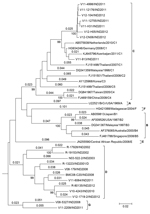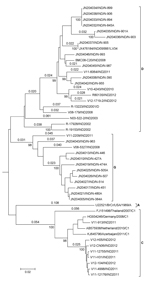Volume 21, Number 1—January 2015
Dispatch
Genetic Diversity of Enterovirus A71, India
Abstract
We have identified circulation of 3 genogroups of enterovirus (EV) A71 in India. A new genogroup (proposed designation G) was discovered during this study. We isolated genogroups D and G in wide geographic areas but detected subgenogroup C1 only in 1 focus in western India. A systematic nationwide search for EV-A71 is warranted.
Enterovirus A71 (EV-A71; enterovirus species A, genus Enterovirus, family Picornaviridae) was first isolated in 1969 from the cerebrospinal fluid of a patient with encephalitis in California, USA. EV-A71 is known to cause encephalitis; meningitis; hand, foot and mouth disease (HFMD); and acute flaccid paralysis (AFP) (1,2). EV-A71 epidemic activity has increased substantially throughout the World Health Organization South-East Asia and Western Pacific Regions since the 1997 outbreak of HFMD with severe neurologic complications and high case-fatality rates reported in Sarawak and peninsular Malaysia (3). In many countries, EV-A71 circulated for several years before large-scale outbreaks were reported (4). In China, several hundred thousand cases of HFMD have been reported in recent years (5). In India, the epidemiology of EV-A71 has remained largely unexplored. A small outbreak of HFMD in Kerala in 2003 and 36 (42%) of 87 encephalitis cases reported in western Uttar Pradesh during July 2004–November 2006 were attributed to EV-A71 infections only on the basis of serologic evidence (6,7). Isolation of EV-A71 from a patient with AFP in India was reported for the first time in 2001 (8). Recently, 2 research groups have reported frequent isolation of EV-A71 from persons with AFP in Uttar Pradesh, Karnataka, and Kerala (9,10).
EV-A71 strains isolated worldwide are classified into 4 genogroups: A–D (11). Genogroups B and C have been differentiated into subgenogroups B0–B5 and C1–C5 (11). Bessaud et al. proposed 2 new genogroups in sub-Saharan Africa (genogroup E) and Madagascar (genogroup F) (12). Other new subgenogroups proposed recently include C4a, C4b, C6, C7, and B6 (9,13). We detected 14 EV-A71 among nonpolio enterovirus (NPEV) isolates from persons with AFP, HFMD, and encephalitis reported in Mumbai and surrounding areas during 2008–2012. The objective of this study was to evaluate the phylogenetic relationship of the Indian EV-A71 strains in the global context.
We studied 561NPEV isolates obtained from 2,530 AFP patients, 89 from 383 HFMD patients, and 1 from 23 encephalitis patients in Mumbai and surrounding areas during 2008–2012. Partial sequencing viral protein 1 (VP1) was used to identify the NPEV (sero) types as described previously (14). Fourteen EV-A71 isolates were thus identified: 10 from AFP patients, 2 from HFMD patients, and 1 each from patients with encephalitis and febrile illness. Five EV-A71 isolates identified at various times since 2002 from northern Indian states were also included in this study (J. Deshpande, unpub. data). The VP1 region of EV-A71–positive isolates was sequenced as described previously (15). Sequencing was done by using Big Dye Terminator v3.1 Cycle Sequencing kit in accordance with the manufacturer’s instructions (Applied Biosystems, Foster City, CA, USA). Sequences were resolved on ABI 3130xl Genetic Analyzer (Applied Biosystems) and edited by using Sequencher v4.10.1 (Gene Codes, Ann Arbor, MI, USA). Complete VP1 sequences were aligned by using ClustalW (http://www.ebi.ac.uk). Phylogenetic analysis was conducted in MEGA5 by using maximum-likelihood and neighbor-joining methods (http://www.megasoftware.net). Genetic distances were calculated by Kimura 2-parameter method. A genotype was defined by >85% nt sequence similarity in the complete VP1 region (12). Sequences were deposited in GenBank under accession nos. KF906416–KF906434.
Median age of patients from whom the EV-A71 strains were isolated was 28 months; 10 (56%) were girls (Table 1). Three EV-A71–positive patients reported in Mumbai had lived in Uttar Pradesh. EV-A71–positive HFMD cases were non-neurologic, and the encephalitis patient recovered completely without neurologic deficit. Medical examination results 60 days after onset were not available for the AFP patients.
Nine isolates clustered with the strain R-13223-IND-01 (GenBank accession no. AY179600) (Figure 1), which was the only representative of EV-A71 genogroup D. A mean genetic distance of 11% and presence of multiple clusters within this genogroup indicated continuous evolution of genogroup D viruses over several years. Eight isolates (5 from AFP patients, 2 from HFMD patients, and 1 from an encephalitis patient) clustered with subgenogroup C1. Sequence similarity of >99% of 6 of the 8 isolates indicated a focal outbreak caused by C1 subgenogroup. Clustering of the subgenogroup C1 isolates with those from Germany, the Netherlands, and Azerbaijan suggested an epidemiologic link with the EV-A71 circulating in the European Region. V08–5327 and V11–2209 had sequence similarity of 89.5% between them and >18% divergence from all other known EV-A71 genogroups. We propose a new genogroup G designation for EV-A71 isolates V08–5327 and V11–2209. Table 2 shows estimates of evolutionary divergence of genogroup G in global context.
To study the genetic diversity among EV-A71 strains isolated in India, we extracted partial VP1 nucleotide sequences of various lengths from GenBank. We detected 50 EV-A71 strains among NPEV isolates from AFP patients in Uttar Pradesh, Kerala, and Karnataka during 2007–2009 (9). Four EV-A71 isolates were reported from AFP patients from Uttar Pradesh studied during 2009–2010 (10). We used 21 sequences of isolates from Rao (9) and 1 of Laxmivandana (10) for determining the genetic relationship of EV-A71 isolated in India. Neighbor-joining tree using partial VP1 (707 nt) sequences (Figure 2) showed that 11 EV-A71 strains assigned to genogroup F by Rao et al. actually clustered within isolates of genogroup D, and the remaining 10 EV-A71 strains clustered within the new genogroup G. None of the EV-A71 isolates of Rao et al. (9) clustered in the subgenogroup C1 (Technical Appendix).
Bessaud et al. very recently reported (12) that 20 partial sequences reported by Rao et al. did not cluster into any known subgenogroup, which suggests more genogroups in India. Our current study confirms that some of them cluster within genogroup G. The remaining sequences from the study of Rao et al. need further analysis on the basis of longer nucleotide sequences.
Our study reports the discovery of a new genogroup G of EV-A71 in India. Genogroups D and G may be endemic in India because they were isolated from AFP patients in wide geographic areas; however, these genogroups have not been implicated in any specific outbreaks. Moreover, the 2 genogroups appear to be indigenous to India because they have not been detected in any other country. EV-A71 strains of subgenogroup C1 were isolated only in 2011–2012, indicating very recent circulation. Subgenogroup C1 was associated with time- and space-clustered cases of AFP, HFMD, and encephalitis. Multiple genogroups and high sequence divergence within genogroups D and G showed that EV-A71 has been spreading across the country. Therefore, systematic efforts should be made to understand the impact of the virus on public health in India.
Dr. Saxena is a research scientist at Enterovirus Research Centre, Mumbai, India. His primary research interest is molecular characterization of enteroviruses.
Acknowledgments
We thank Uma Nalavade for the NPEV used in this study. We also thank the 2 anonymous reviewers for suggestions that led to substantial improvement of the manuscript.
This study was supported by intramural funds from the Indian Council of Medical Research, New Delhi, India.
References
- Schmidt NJ, Lennette EH. HoH. An apparently new enterovirus isolated from patients with disease of the central nervous system. J Infect Dis. 1974;129:304–9. DOIPubMedGoogle Scholar
- Pallansch M, Roos R. Enteroviruses: polioviruses, coxsackieviruses, echoviruses and newer enteroviruses. In: Knipe DM, Howley PM, editors. Fields virology. 5th ed. Philadelphia: Lippincott Williams & Wilkins; 2007. p. 839–93.
- AbuBakar S, Chee HY, Al-Kobaisi MF, Xiaoshan J, Chua KB, Lam SK. Identification of enterovirus 71 isolates from an outbreak of hand, foot and mouth disease (HFMD) with fatal cases of encephalomyelitis in Malaysia. Virus Res. 1999;61:1–9. DOIPubMedGoogle Scholar
- Tee KK, Lam TT, Chan YF, Bible JM, Kamarulzaman A, Tong CY, Evolutionary genetics of human enterovirus 71: origin, population dynamics, natural selection and seasonal periodicity of the VP1 gene. J Virol. 2010;84:3339–50. DOIPubMedGoogle Scholar
- Lu Q-B, Zhang XA, Wo Y, Xu HM, Li XJ, Wang XJ, Circulation of coxsackievirus A10 and A6 in hand-foot-mouth disease in China, 2009–2011. PLoS ONE. 2012;7:e52073. DOIPubMedGoogle Scholar
- Sasidharan CK, Sugathan P, Agarwal R, Khare S, Lal S, Jayaram Paniker CK. Hand-foot-and-mouth disease in Calicut. Indian J Pediatr. 2005;72:17–21. DOIPubMedGoogle Scholar
- Beig FK, Malik A, Rizvi M, Acharya D, Khare S. Etiology and clinico-epidemiological profile of acute viral encephalitis in children of western Uttar Pradesh, India. Int J Infect Dis. 2010;14:e141–6. DOIPubMedGoogle Scholar
- Deshpande JM, Nadkarni SS, Francis PP. Enterovirus 71 isolated from a case of acute flaccid paralysis in India represents a new genotype. Curr Sci. 2003;84:1350–3.
- Rao CD, Yergolkar P, Shankarappa KS. Antigenic diversity of enteroviruses associated with nonpolio acute flaccid paralysis, India, 2007–2009. Emerg Infect Dis. 2012;18:1833–40. DOIPubMedGoogle Scholar
- Laxmivandana R, Yergolkar P, Gopalkrishna V, Chitambar SD. Characterization of the non-polio enterovirus infections associated with acute flaccid paralysis in south-western India. PLoS ONE. 2013;8:e61650. DOIPubMedGoogle Scholar
- McMinn PC. Recent advances in the molecular epidemiology and control of human enterovirus 71 infection. Curr Opin Virol. 2012;2:199–205.
- Bessaud M, Razafindratsimandresy R, Nougairede A, Joffret ML, Deshpande JM. Dubot-PeresA, et al.Molecular comparison and evolutionary analyses of VP1 nucleotide sequences of new African human enterovirus 71 isolates reveal a wide genetic diversity.PLoS ONE.2014;9:e90624.
- Yip CC, Lau SK, Lo JY, Chan KH, Woo PC, Yuen KY. Genetic characterization of EV71 isolates from 2004 to 2010 reveals predominance and persistent circulation of the newly proposed genotype D and recent emergence of a distinct lineage of subgenotype C2 in Hong Kong. Virol J. 2013;10:222. DOIPubMedGoogle Scholar
- Oberste MS, Maher K, Kilpatrick DR, Flemister MR, Brown BA, Pallansch MA. Typing of human enteroviruses by partial sequencing of VP1. J Clin Microbiol. 1999;37:1288–93 .PubMedGoogle Scholar
- Oberste MS, Penaranda S, Maher K, Pallansch MA. Complete genome sequences of all members of the species human enterovirus A. J Gen Virol. 2004;85:1597–607. DOIPubMedGoogle Scholar
Figures
Tables
Cite This ArticleTable of Contents – Volume 21, Number 1—January 2015
| EID Search Options |
|---|
|
|
|
|
|
|


Please use the form below to submit correspondence to the authors or contact them at the following address:
Jagadish M. Deshpande, Enterovirus Research Centre, Haffkine Institute Compound, AD Marg, Parel, Mumbai 400012, India
Top